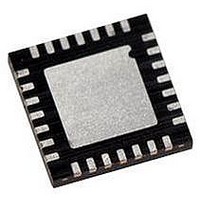PIC16LF723A-I/ML Microchip Technology, PIC16LF723A-I/ML Datasheet - Page 120

PIC16LF723A-I/ML
Manufacturer Part Number
PIC16LF723A-I/ML
Description
MCU PIC 3.5K FLASH XLP 28-QFN
Manufacturer
Microchip Technology
Series
PIC® XLP™ 16Fr
Specifications of PIC16LF723A-I/ML
Core Size
8-Bit
Program Memory Size
7KB (4K x 14)
Peripherals
Brown-out Detect/Reset, POR, PWM, WDT
Core Processor
PIC
Speed
20MHz
Connectivity
I²C, SPI, UART/USART
Number Of I /o
25
Program Memory Type
FLASH
Ram Size
192 x 8
Voltage - Supply (vcc/vdd)
1.8 V ~ 3.6 V
Data Converters
A/D 11x8b
Oscillator Type
Internal
Operating Temperature
-40°C ~ 85°C
Package / Case
28-VQFN Exposed Pad, 28-HVQFN, 28-SQFN, 28-DHVQFN
Controller Family/series
PIC16LF
No. Of I/o's
25
Ram Memory Size
192Byte
Cpu Speed
20MHz
No. Of Timers
3
Lead Free Status / RoHS Status
Lead free / RoHS Compliant
Eeprom Size
-
Lead Free Status / RoHS Status
Lead free / RoHS Compliant, Lead free / RoHS Compliant
- Current page: 120 of 284
- Download datasheet (3Mb)
PIC16F/LF722A/723A
14.6
The capacitive sensing oscillator will continue to run as
long as the module is enabled, independent of the part
being in Sleep. In order for the software to determine if
a frequency change has occurred, the part must be
awake. However, the part does not have to be awake
when the timer resource is acquiring counts. One way
to acquire the Timer1 counts while in Sleep is to have
Timer1 gated with the overflow of the Watchdog Timer.
This can be accomplished using the following steps:
1.
2.
3.
4.
5.
6.
7.
8.
9.
Refer to Section 12.0 “Timer1 Module with Gate
Control” for additional information.
DS41417A-page 120
Note 1: When using the WDT to set the interval
Configure the Watchdog Time-out overflow as
the Timer1’s gate source T1GSS<1:0> = 11.
Set Timer1 gate to toggle mode by setting the
T1GTM bit of the T1GCON register.
Set the TMR1GE bit of the T1GCON register.
Set TMR1ON bit of the T1CON register.
Enable capacitive sensing module with the
appropriate current settings and pin selection.
Clear Timer1.
Put the part to Sleep.
On the first WDT overflow, the capacitive sens-
ing oscillator will begin to increment Timer1.
Then put the part to Sleep.
On the second WDT overflow Timer1 will stop
incrementing. Then run the software routine to
determine if a frequency change has occurred.
2: Timer0 does not operate when in Sleep,
Operation During Sleep
on Timer1, any other source that wakes
the part up early will cause the WDT over-
flow to be delayed, affecting the value
captured by Timer1.
and therefore cannot be used for
capacitive
Sleep.
sense
measurements
in
2010 Microchip Technology Inc.
Related parts for PIC16LF723A-I/ML
Image
Part Number
Description
Manufacturer
Datasheet
Request
R

Part Number:
Description:
IC PIC MCU FLASH 8KX14 28-SPDIP
Manufacturer:
Microchip Technology
Datasheet:

Part Number:
Description:
IC PIC MCU FLASH 8KX14 28-QFN
Manufacturer:
Microchip Technology
Datasheet:

Part Number:
Description:
IC PIC MCU FLASH 8KX14 28-SPDIP
Manufacturer:
Microchip Technology
Datasheet:

Part Number:
Description:
IC PIC MCU FLASH 8KX14 28-QFN
Manufacturer:
Microchip Technology
Datasheet:

Part Number:
Description:
IC PIC MCU FLASH 8KX14 28-SOIC
Manufacturer:
Microchip Technology
Datasheet:

Part Number:
Description:
IC PIC MCU FLASH 8KX14 28-SSOP
Manufacturer:
Microchip Technology
Datasheet:

Part Number:
Description:
IC PIC MCU FLASH 8KX14 28-SSOP
Manufacturer:
Microchip Technology
Datasheet:

Part Number:
Description:
7 KB Flash, 16 MHz Int. Osc, NanoWatt XLP 28 SOIC .300in TUBE
Manufacturer:
Microchip Technology
Datasheet:

Part Number:
Description:
IC PIC MCU FLASH 2KX14 28SOIC
Manufacturer:
Microchip Technology
Datasheet:

Part Number:
Description:
IC PIC MCU FLASH 2KX14 28QFN
Manufacturer:
Microchip Technology
Datasheet:

Part Number:
Description:
IC PIC MCU FLASH 2KX14 28DIP
Manufacturer:
Microchip Technology
Datasheet:

Part Number:
Description:
IC MCU FLASH 2KX14 28SOIC
Manufacturer:
Microchip Technology

Part Number:
Description:
IC PIC MCU FLASH 2KX14 28QFN
Manufacturer:
Microchip Technology

Part Number:
Description:
IC PIC MCU FLASH 2KX14 28SSOP
Manufacturer:
Microchip Technology
Datasheet:

Part Number:
Description:
IC, 8BIT MCU, PIC16LF, 32MHZ, QFN-28
Manufacturer:
Microchip Technology
Datasheet:










